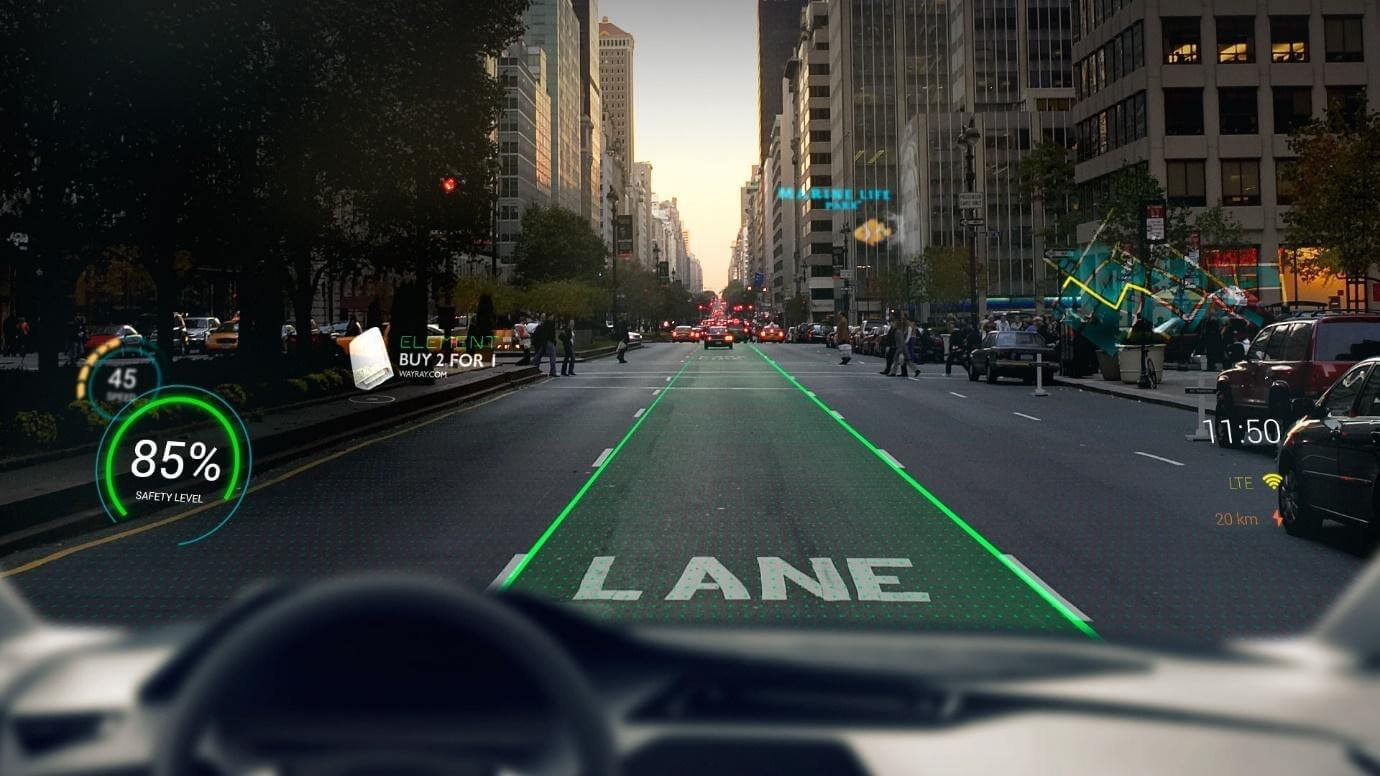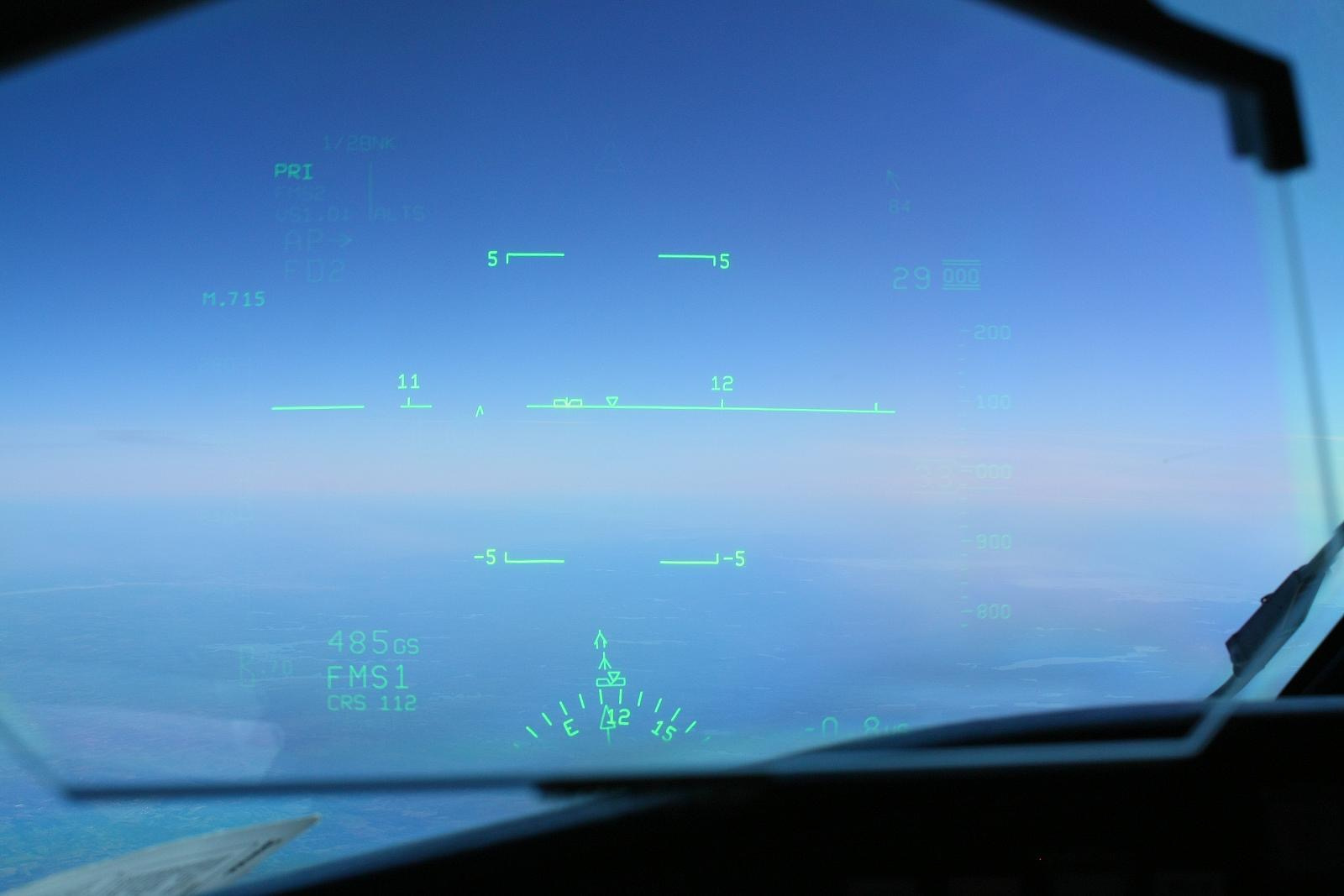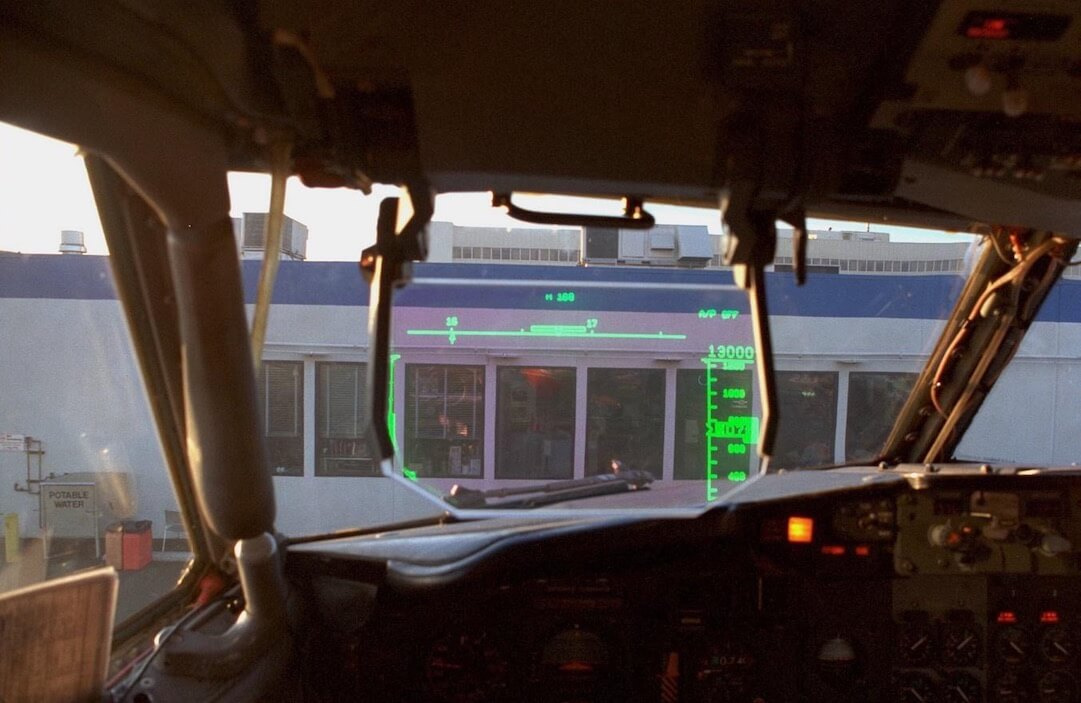“HUD Story”: from World War II to First Hologram
The dashboard of the car - the source of important information for the driver. In the near future, it risks losing its importance - HUD displays are already applying for this place, the technology of which we would like to talk about today.
It all started with the reflex sights of combat aircraft. Decades later, technology was developed in civil aviation and the automotive industry.
This decision formed the basis of one of the WayRay products. This is the AR navigation system Navion , which allows you to integrate all the important information: route, current speed, POI - directly into the surrounding reality.
')

Wayray image
We will look at how it all began, and how developments for military aviation continue to change the modern civilian auto industry.
Like many inventions that still serve us in everyday life, HUD technology has come from the military industry. The ancestors of transparent displays can be considered reflex sights on combat German aircraft from the Second World War. HUD technology arose from the need for pilots to find hostile targets in the sky, using navigation information and without distracting themselves from the flight.
The first displays solved the problem of aiming, and then began to display details about the speed of movement and the angle of attack, which was a milestone for military aircraft. In 1942, the image from the radar indicator was able to be connected with the projection of the gyroscopic sight on the flat surface of the windshield, and this led to the birth of the projection display.

Shawn / CC-BY Photo
HUD remained in combat aircraft after World War II. The next stage in the evolution of information displays is to equip the British Blackburn Buccaneer attack aircraft with a built-in Head-Up Display. The first flight and practical application of HUD in the air occurred in 1958. Again, the technology served not peaceful purposes: it helped in pointing missiles and attacks from low altitude. The British piloted the Buccaneer from 1968 to 1994, and all this time important information for pilots was displayed on the glass.
In the 60s of the 20th century, the French test pilot Gilbert Klopfstein created the first modern HUD and standardized character system for it. Due to this, the pilots could, without additional training, change at the helm of various combat vehicles. As with many technologies, the unification has taken HUD use to a new level.
Entering the peaceful sky did not become the next stage in the evolution of HUD, because the war period for displays did not end there, and this is unlikely to happen ever. Projection display and augmented reality technologies continue to be used both in aviation and in other aspects of military affairs: soldiers use Google Glass counterparts to set goals, and the picture that appears before their eyes is very similar to the work of HUD in modern cars.
Projection displays took “some” thirty years to find application in the peaceful sector: HUD found a place in the Boeing 737 only in the 1990s, although the earliest attempts to instill in the pilots the habit of monitoring the flight parameters on the screen were already in the 1970s. x The projected information helps take off and land, monitor the speed, altitude and routes not only on mass passenger ships like the Boeing 737 or Embraer 190, but also on regional jets and even business jets .

Shawn / CC-BY Photo
In passenger aviation, the next step for HUD, according to Aviation Today, should be a combination of artificial and infrared vision technologies. New generation systems already consist of a remote processor that interprets information about the location of the aircraft and combines it with the built-in database. The resulting picture is transmitted to a small projector mounted above the pilot's head.
Although this thought would have met a certain skepticism some thirty years ago, transparent displays were released to the masses thanks to the automotive industry.
The pioneer in the use of HUD on the basis of the production car was the General Motors Corporation with a model of the already ceased to exist Oldsmobile brand - Cutlass Supreme - in 1988. It is customary to think so, but the truth is that GM experimented with transparent displays back in the 60s, that is, it happened at the same time as the first Buccaneer flights with HUD.
Then the corporations were not afraid to make public photos of concept cars. One of the early sketches of the legendary Mako Shark II of the 65th year contained a real device for displaying onboard information. In a primitive, but recognizable form. The HUD on the Mako never came out, nor was the improved version of the sports coupe.
The next two decades, the technology had few points of contact with the earth, and the mass consumer still did not know about its existence. HUD flashed in the futuristic concept of Pontiac Trans Sport in 1986, but, as history has shown, this model became an ordinary minivan, in which there was no room for innovation.
And then came the year 1988. The updated Oldsmobile Cutlass Supreme, the one that was used for the filming of "Deadly Weapons." In addition to the unsurpassed style of the time, the car had a vacuum fluorescent tube and reflective optics, which together were able to project all the useful information about riding a windshield.
Soon after, the technology began to spread. Early models were monochromatic. By the end of the 90s, the Corvette was already equipped with a HUD with tachometers and an engine temperature indicator. Pontiac later adopted the HUD as standard at Bonneville. In 2005, based on the Cadillac STS, the world's first four-color HUD was proposed.
For a long time, the transparent screen remained a luxury bonus, available only in premium models. At the same time, the projected picture suffered from a low resolution and did not always correspond to a high bar. In 2009, research began on a projection device using holographic projection technology.
The basis of such projectors is a liquid crystal on silicon (LCOS) for modulating the rays of red, green and blue light, which ultimately creates a full-fledged image. After 6 years Jaguar Land Rover adopted them for their cars.
According to the report of IHS Automotive, by 2020, more than 9 million vehicles with HUD will appear on the roads - this is due, in particular, to the cheaper implementation of HUD solutions. Another direction of technology development in the context of the automotive industry is perfection on the way to full-fledged augmented reality.
The present and future of WayRay Navion is connected with the second direction and relies in this on a holographic combiner - a mirror that combines the picture and the image of the real world. This approach allows us to achieve the largest (compared to other projection systems) angular image size and increase the distance to the formed picture on the road. The sharp increase in the angular size allows you to display images, combined with the real world (annotations to objects), and “draw” a route right on the road.
In addition, Navion, in contrast to the "classic" HUD, is able to "control" the distance to the imaged image. We call it “True AR” - it allows you to display information on the glass in such a way that it “falls” on real objects, and the pilot does not distract from the road, because the eye does not have to refocus on the picture on the HUD.
As for the industry as a whole, in addition to the improvement of display technologies, there is also a trend towards the growth of augmented reality functionality. Companies moving along the AR path combine HUDs with various sensors and add so-called “intellectual information” to the holographic display: warnings about driving out of a lane and about the risk of colliding with objects.
Such developments can hardly be called just HUD - these are full-fledged AR solutions that the creators of the first “transparent displays” could hardly have imagined. So technology, decades ago used by military pilots, became the progenitor of the development, which turned the car into an artifact from the “future that has already come.”
It all started with the reflex sights of combat aircraft. Decades later, technology was developed in civil aviation and the automotive industry.
This decision formed the basis of one of the WayRay products. This is the AR navigation system Navion , which allows you to integrate all the important information: route, current speed, POI - directly into the surrounding reality.
')

Wayray image
We will look at how it all began, and how developments for military aviation continue to change the modern civilian auto industry.
War period
Like many inventions that still serve us in everyday life, HUD technology has come from the military industry. The ancestors of transparent displays can be considered reflex sights on combat German aircraft from the Second World War. HUD technology arose from the need for pilots to find hostile targets in the sky, using navigation information and without distracting themselves from the flight.
The first displays solved the problem of aiming, and then began to display details about the speed of movement and the angle of attack, which was a milestone for military aircraft. In 1942, the image from the radar indicator was able to be connected with the projection of the gyroscopic sight on the flat surface of the windshield, and this led to the birth of the projection display.

Shawn / CC-BY Photo
HUD remained in combat aircraft after World War II. The next stage in the evolution of information displays is to equip the British Blackburn Buccaneer attack aircraft with a built-in Head-Up Display. The first flight and practical application of HUD in the air occurred in 1958. Again, the technology served not peaceful purposes: it helped in pointing missiles and attacks from low altitude. The British piloted the Buccaneer from 1968 to 1994, and all this time important information for pilots was displayed on the glass.
In the 60s of the 20th century, the French test pilot Gilbert Klopfstein created the first modern HUD and standardized character system for it. Due to this, the pilots could, without additional training, change at the helm of various combat vehicles. As with many technologies, the unification has taken HUD use to a new level.
Passenger aircraft
Entering the peaceful sky did not become the next stage in the evolution of HUD, because the war period for displays did not end there, and this is unlikely to happen ever. Projection display and augmented reality technologies continue to be used both in aviation and in other aspects of military affairs: soldiers use Google Glass counterparts to set goals, and the picture that appears before their eyes is very similar to the work of HUD in modern cars.
Projection displays took “some” thirty years to find application in the peaceful sector: HUD found a place in the Boeing 737 only in the 1990s, although the earliest attempts to instill in the pilots the habit of monitoring the flight parameters on the screen were already in the 1970s. x The projected information helps take off and land, monitor the speed, altitude and routes not only on mass passenger ships like the Boeing 737 or Embraer 190, but also on regional jets and even business jets .

Shawn / CC-BY Photo
In passenger aviation, the next step for HUD, according to Aviation Today, should be a combination of artificial and infrared vision technologies. New generation systems already consist of a remote processor that interprets information about the location of the aircraft and combines it with the built-in database. The resulting picture is transmitted to a small projector mounted above the pilot's head.
Daily use
Although this thought would have met a certain skepticism some thirty years ago, transparent displays were released to the masses thanks to the automotive industry.
The pioneer in the use of HUD on the basis of the production car was the General Motors Corporation with a model of the already ceased to exist Oldsmobile brand - Cutlass Supreme - in 1988. It is customary to think so, but the truth is that GM experimented with transparent displays back in the 60s, that is, it happened at the same time as the first Buccaneer flights with HUD.
Then the corporations were not afraid to make public photos of concept cars. One of the early sketches of the legendary Mako Shark II of the 65th year contained a real device for displaying onboard information. In a primitive, but recognizable form. The HUD on the Mako never came out, nor was the improved version of the sports coupe.
The next two decades, the technology had few points of contact with the earth, and the mass consumer still did not know about its existence. HUD flashed in the futuristic concept of Pontiac Trans Sport in 1986, but, as history has shown, this model became an ordinary minivan, in which there was no room for innovation.
And then came the year 1988. The updated Oldsmobile Cutlass Supreme, the one that was used for the filming of "Deadly Weapons." In addition to the unsurpassed style of the time, the car had a vacuum fluorescent tube and reflective optics, which together were able to project all the useful information about riding a windshield.
Soon after, the technology began to spread. Early models were monochromatic. By the end of the 90s, the Corvette was already equipped with a HUD with tachometers and an engine temperature indicator. Pontiac later adopted the HUD as standard at Bonneville. In 2005, based on the Cadillac STS, the world's first four-color HUD was proposed.
For a long time, the transparent screen remained a luxury bonus, available only in premium models. At the same time, the projected picture suffered from a low resolution and did not always correspond to a high bar. In 2009, research began on a projection device using holographic projection technology.
The basis of such projectors is a liquid crystal on silicon (LCOS) for modulating the rays of red, green and blue light, which ultimately creates a full-fledged image. After 6 years Jaguar Land Rover adopted them for their cars.
What's next?
According to the report of IHS Automotive, by 2020, more than 9 million vehicles with HUD will appear on the roads - this is due, in particular, to the cheaper implementation of HUD solutions. Another direction of technology development in the context of the automotive industry is perfection on the way to full-fledged augmented reality.
The present and future of WayRay Navion is connected with the second direction and relies in this on a holographic combiner - a mirror that combines the picture and the image of the real world. This approach allows us to achieve the largest (compared to other projection systems) angular image size and increase the distance to the formed picture on the road. The sharp increase in the angular size allows you to display images, combined with the real world (annotations to objects), and “draw” a route right on the road.
In addition, Navion, in contrast to the "classic" HUD, is able to "control" the distance to the imaged image. We call it “True AR” - it allows you to display information on the glass in such a way that it “falls” on real objects, and the pilot does not distract from the road, because the eye does not have to refocus on the picture on the HUD.
As for the industry as a whole, in addition to the improvement of display technologies, there is also a trend towards the growth of augmented reality functionality. Companies moving along the AR path combine HUDs with various sensors and add so-called “intellectual information” to the holographic display: warnings about driving out of a lane and about the risk of colliding with objects.
Such developments can hardly be called just HUD - these are full-fledged AR solutions that the creators of the first “transparent displays” could hardly have imagined. So technology, decades ago used by military pilots, became the progenitor of the development, which turned the car into an artifact from the “future that has already come.”
Source: https://habr.com/ru/post/373791/
All Articles